Menu
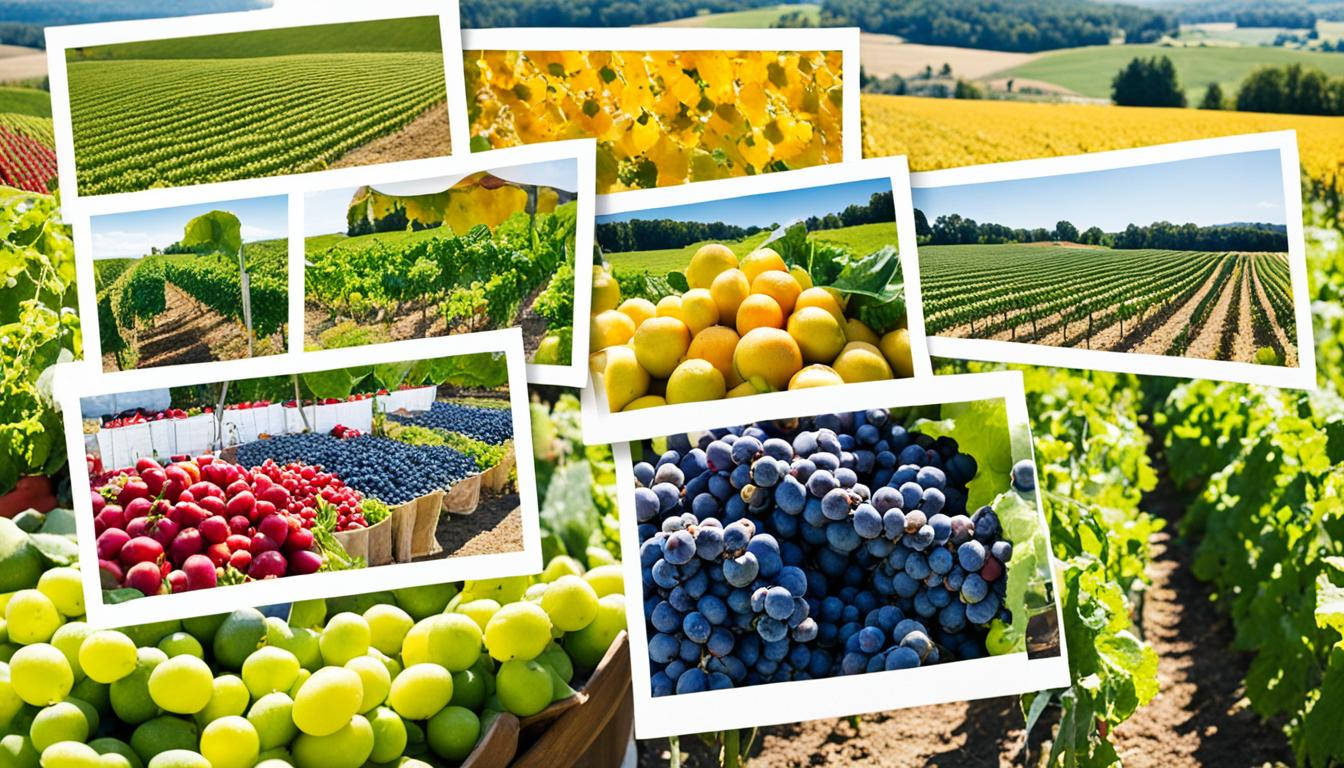
Did you know a survey at six North Carolina agritourism farms in 2018-2019 showed something interesting? It found that visitors were more likely to buy local food after their visits. This happened because visiting these farms made people more interested in their local food systems.
So, when people visit agritourism sites, it’s good for the rural areas and the local people. These places let visitors see where their food comes from. This helps in making better environmental and economic choices about food. It shows how vacationing on farms helps those areas come alive again. It also makes visitors want to support the ways of growing food that are good for the earth.
Local food movements like agritourism are becoming crucial in our changing world. They bridge the gap between food producers and us, which has grown wider because of farming practices and global trade. The USDA started the Know Your Farmer, Know Your Food programme in 2009. This effort aims to teach us about local food and supports buying locally grown produce.
Studies find that community food systems build strong bonds among people and help the local economy. They make it easier for us to know where our food comes from. This makes our social web stronger. With the COVID-19 outbreak, we saw how important it is to have local farmers we can rely on for food.
The Tiers of the Food System model shows different levels of connection to our food. It starts with growing food at home (Tier 0) and goes up to buying from farmers directly (Tier 1). Tier 0 is about personal food growth and being self-reliant. Tier 1 includes buying from farmers directly, like at markets and stands. This boosts agritourism and local food efforts.
In North Carolina, more and more people are keen on eating locally. This has grown in the last ten years. Many small farmers there open their farms to visitors. This not only helps them earn more but also strengthens their ties with the community. To support this, an agritourism training program was launched in 2018. It has 8 parts, including making a business plan for interested farms.
Agritourism has become widely popular over the years, both in the United States and across the globe. It’s grown to be a crucial way for farmers to make money. Fun activities like pumpkin picking patches and U-Pick operations attract people and help farmers financially.

From a historical perspective, agritourism started when people were losing connection with where their food comes from. Farmers saw an opportunity in agritourism local food to directly sell their products to visitors. This not only brings in more money but also teaches about sustainable farming.
Communities also gain a lot from agritourism. It brings in more taxes, creates new jobs, and helps keep farmlands from being developed. States are making laws to support the safe growth of agritourism. These laws help protect both visitors and the farmers running the activities.
But, getting into agritourism has its own set of hurdles. Farmers need to deal with laws on who’s responsible if someone gets hurt on their land. They must also follow zoning laws, make sure their buildings are safe, handle food rules, and get the right insurance. Knowing and tackling these issues is key for agri-businesses to last.
Agritourism is changing how people think about where their food comes from. By visiting farms and having fun, people learn to value local food more. This interaction brings educational and financial good to everyone involved.
Agritourism is great for farmers and shoppers. It helps farmers earn money in new ways and brings more people to the countryside. This is good for education on farm life and supports farming that cares for the environment.
Agritourism helps farms make more money in different ways. Between 2002 and 2017, the money farms made this way tripled, reaching almost $950 million in 2017. This extra income was crucial, making up 5.6% of all farm money in 2017.
Farms in busy areas made more money from this as more people visited them. This shows how important visitors are to farm incomes.
A big plus of agritourism is teaching people more about farming. When people visit farms, they learn where food comes from and how it’s grown. A big study found people are willing to spend more on local food after visiting these places. They also want to buy local products more and check food labels to see where things are made.
Agritourism helps farmers do their job in a way that’s good for the planet and their wallets. By taking people right to the farms, it shows the work in sustainable farming and the value of local food. After such visits, people felt buying local was better for the Earth.
Agritourism is common in places known for special food, like wine valleys. This shows how visiting these places can help the economy and local farmers.
| Statistic | Data |
|---|---|
| Agritourism revenue in 2012 (inflation-adjusted) | $704 million |
| Agritourism revenue in 2017 (inflation-adjusted) | $950 million |
| Percentage of farm-related income from agritourism in 2017 | 5.6% |
| Visitors reported increase in monthly food budget for local foods | 20% |
To sum up, agritourism is key to helping farmers make more, teaching the public about farms, and supporting ways of farming that are good for the planet. It’s a vital part of the farming of today.
The idea of farm-to-table cuisine is at the core of the local food movement. It means restaurants get their food from nearby farms. Doing this makes food taste fresher and builds a strong relationship between chefs and farmers.
An example is Silva Ilda, which changes its menu weekly to use the freshest produce. This working relationship sparks creative dishes and respect between farmers and chefs. It shows what culinary agritourism is really about.
Farms like Assateague Farm have gained huge followings on social media, with 18,000 fans on Instagram. This proves that people are very interested in food that comes from local sources and they want to know the story behind their meals.

Then there are groups like EmPOWERing Mountain Food Systems. They help local farms and food businesses with advice and support. Their work encourages tourism around food, helps local economies, and fights climate change by storing carbon.
Some facts show how important the local food movement is. The sale of local food in the US grew from $5 billion in 2008 to $11.8 billion in 2017, hitting $9 billion in 2020. Spending on local products also creates more local jobs and money.
Places like Achterberg Acres, popular for its pastured meat, and Floating Lotus Farmstead with all its food boxes, offer choices that customers love. Chesapeake Gold Farms makes getting local food easy with a simple click to buy and have it delivered. This trend shows how farm-to-table is changing for the better for shoppers.
| Farm | Speciality | Consumer Engagement |
|---|---|---|
| Silva Ilda | Weekly updated menu | High culinary engagement |
| Assateague Farm | Social Media Presence | 18,000+ Instagram followers |
| Achterberg Acres | Pastured Pork & Chicken | Waiting list for products |
| Chesapeake Gold Farms | One-click buying and delivery | Increased accessibility |
Agritourism boosts the sale of fresh farm produce. It connects farmers directly with consumers. This creates a special bond and appreciation for local food. Two main activities, farm markets and you-pick farms, are key in selling more produce.
On-site markets are crucial in agritourism. They let farmers show their fresh produce to the public. Buying straight from the farm is very appealing. This way of selling helps customers see the farming process.
Farms near cities make more money from agritourism. Ease of access makes people buy more farm goods. This boosts sales a lot. Also, selling food directly to the consumer means more profit over the years.
You-pick farms are another hit in agritourism. They let visitors pick their own fruits and veggies. This hands-on experience makes people come back. It links the customer closely with the farm.
These farms are beloved by families and groups. They offer fun and learning about farming. This makes people more likely to buy the produce they pick. Farms with special crops or animals can earn more from agritourism.
In summary, both farm markets and you-pick farms help sell more fresh produce. They give fun and unique ways for people to meet and support farmers. This not only attracts but keeps customers, which helps farmers financially.
Rural tourism experiences are becoming more popular. They draw in many travellers to places that celebrate nature and farming. This type of tourism, called agritourism, is growing fast worldwide, more than any other part of tourism. People are attracted to the beautiful settings and the chance to do outdoor activities.

There’s a lot to do in agritourism. At U-Pick Farms, visitors can pick their own berries and flowers. They can get the freshest food straight from the fields. There’s also the chance to visit breweries and wineries. Here, you can taste great beers and wines. You can also learn about how they’re made on tours.
Special events happen throughout the year. In the autumn, places with mazes, pumpkin patches, and petting farms are full of life. They’re perfect for families wanting to have fun together. For those who enjoy hunting, these areas offer guided hunts in beautiful settings.
Another exciting thing to do is trail-riding on farms and ranches. It’s a peaceful way to see nature up close. Staying on a farm adds to the adventure. Here, you can live like a farmer for a bit, doing things like fishing. Plus, you get to stay in cosy, rural places.
Food is a big part of these rural adventures too. There are special dinners and markets where the food is as local as it gets. Eating here connects visitors with the land and the people who grow food. It’s tasty and good for the planet, teaching the importance of living sustainably.
Agritourism helps tourists find unforgettable experiences while also supporting local economies. By giving back to rural areas, it helps communities and the environment. It’s an enjoyable way to travel that makes a positive impact.
| Activity | Experience Detail |
|---|---|
| U-Pick Farms | Pick your own berries, vegetables, and flowers |
| Breweries & Wineries | Craft beers, wines, and educational tours |
| Seasonal Events | Mazes, pumpkin patches, and petting farms |
| Hunting Destinations | Guided hunts in scenic locations |
| Trail-Riding | Nature excursions on farms and ranches |
| Farm Stays | Overnight stays with farm activities |
| Farm-to-Table Events | Dining with locally sourced ingredients |
Community-supported agriculture (CSA) is key for local food connection. It allows people to subscribe and get farm fresh goods. This builds a strong link between the locals and their food source.
CSA is changing how we engage with local food. A 1999 survey showed CSAs are growing fast in the United States. Resources like the CSA Innovation Network help farmers connect better with buyers. The FairSHARE CSA Coalition in Madison also works hard to connect farmers and locals.
CSA helps farmers share risks and rewards. This makes the economy better for small farms. The Department of Agricultural and Resource Economics aids in making good CSA contracts. They help with materials to form solid agreements.
The University of Maryland and Oregon State support CSAs too. They provide farmers with tips on how to be more efficient and stay in business longer. This preserves small farms and their economic power.
| Resource | Description |
|---|---|
| CSA Innovation Network | A resource base of programmes and tools supporting CSA initiatives. |
| FairSHARE CSA Coalition | Supports farmers and consumers in Madison, Wisconsin, through CSA projects. |
| Department of Agricultural and Resource Economics | Develops materials to assist in creating CSA contracts. |
| University of Maryland | Publishes model CSA agreements for best practices. |
| Oregon State University | Works towards improving small-farm production and business longevity. |
Adding organic farming to agritourism makes visits better for people and helps the planet. Plus, it meets the rise in wanting green and lasting farming ways. By becoming a big part of the $10.7 billion Global Agritourism Market by 2028, it not only helps our environment but also local areas.
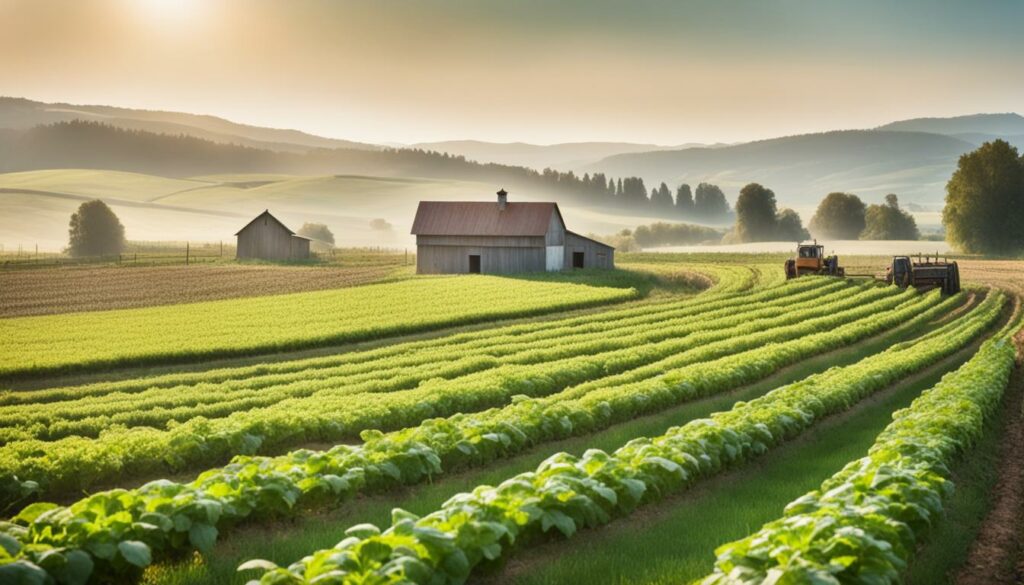
Organic farming gives local places a boost as more people visit. These visits turn organic farms into spots for learning eco-friendly farming. It teaches visitors how important it is to farm in ways good for the Earth.
Many activities like staying at a farm, workshops, and tours help farmers earn more money. This means they don’t rely on just one way to make a living. It also brings jobs to rural areas, which stops people from moving to the cities.
Choosing organic saves many plants and animals by saving their homes in the soil. This supports a quarter of our planet’s living things. Not only that, using the land wisely keeps the countryside beautiful for guests to enjoy.
Integrating organic farming into travel boosts the future of farms. It not only helps our planet but also local businesses. This way, visiting farms doesn’t just educate but helps our environment and local areas thrive beyond measure.
Farm stays let guests dive into the calm life of agritourism. You can stay on working farms, joining in daily farm work. This includes activities like milking cows and gathering crops. You’ll learn about eco-friendly farming. And you’ll get close to the local food scene through hands-on experiences.
Across the United States, many farms offer unique stays. In Vermont, Liberty Hill Farm welcomes guests since 1984, with prices from $80 to $170 a night. You’ll learn a lot about New England’s farming history there.
In Oregon, Leaping Lamb Farm offers stays from $295 at the cottage and $395 at the farmhouse, with breakfast included. It’s perfect for a comfortable farm experience.
California’s Morning Song Farm has rates from $150 to $300 each night. It’s a great choice for exploring Southern California’s farms.
If you’re heading to Utah, Arrowhead Country Inn & Cabins has cabins from $179 a night, including breakfast. This place is great for nature lovers looking for a farm adventure.
The Inn on Lake Champlain in New York takes a unique approach. Prices range from $140 to $175, with guests helping out on the farm. It gives visitors a real taste of farm life.
In Bitterroot Valley, Montana, ABC Acres offers stays from $275 to $400 a night. It’s known for eco-friendly luxury stays.
Verdant View Farm in Pennsylvania offers stays from $139, including breakfast. They focus on traditional ways of farming.
In New Hampshire, The Inn at East Hill Farm offers full board from $57 to $204 per person. It’s a great deal for a whole farm experience.
Farm stays blend tourism with farming, offering deep and inspiring stays. They help visitors value local farming, encouraging sustainable food choices. These stays make a big impact on how we think about food and the environment.
The story of agritourism in North Carolina shows how different projects changed the farming scene. With the fall in traditional earnings from crops like tobacco, farmers looked to agritourism for new income. This shift helps them economically and keeps rural areas busy with tourism.
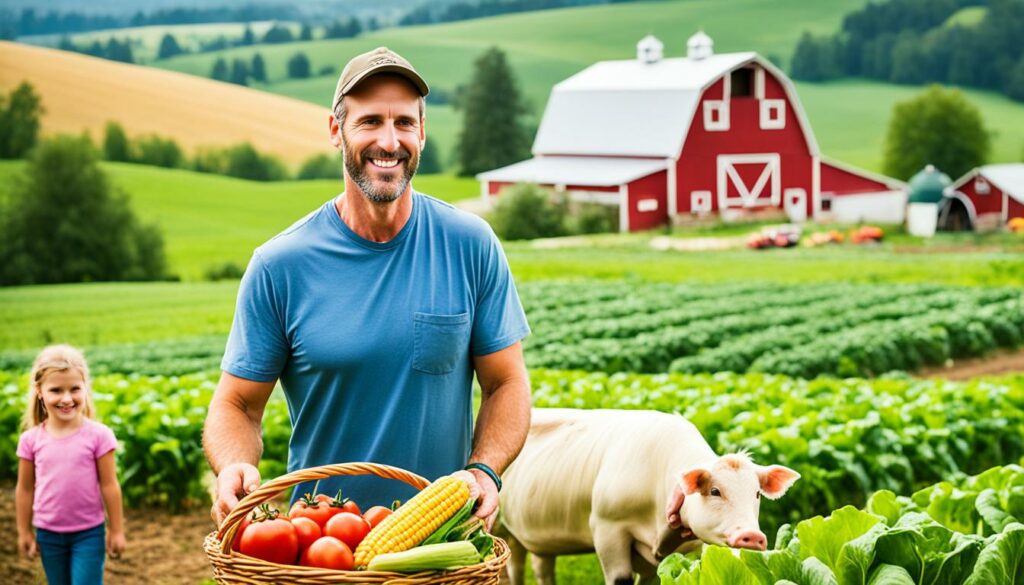
In North Carolina, many farms found success by turning to agritourism. The North Carolina Agritourism Networking Association has been key in this, teaching farmers the best ways and encouraging teamwork. Efforts like weddings, farm stays, and tours have worked really well. Research and writings support women’s remarkable achievements in agritourism, showing its bright future.
Though well, North Carolina’s agritourism faces some problems. Bad weather and legal risks worry those involved. It’s also tough to meet all necessary safety rules. But, there’s a lot of room for it to grow. Working with groups like the American Indian Alaska Native Tourism Association (AIANTA) can help greatly, especially for tribal projects. Advice from the AgrifoodGateway is crucial for those starting agritourism.
Research keeps highlighting the good of agritourism in North Carolina, with reports like “Agritourism Opportunities for Farm Diversification”. The ability of big farms to draw in and host visitors shows how essential agritourism is for the countryside’s economy.
Culinary agritourism blends fine dining with farming. North Carolina leads this movement, where chefs partner with local farmers. This aims to create dishes that celebrate the area’s farming history.
The Fork to Farmer Initiative stands out here. It’s more than just getting food from farms. It tells the stories of the food and educates people. Videos on the Local Food YouTube channel show how chefs and farmers help each other. This effort also trains farmers to welcome guests. It makes the experience better for those visiting or eating at restaurants.
Permatourism looks at how chefs can draw people to farms. It brings in more money and highlights eco-friendly ways of cooking. When people visit, they can do lots of fun things. This includes farm tours and learning about food production. It all helps visitors see and value local food more.
Culinary agritourism is any fun or learning activity on a farm that helps farmers earn more money. North Carolina has many such activities, like festivals and workshops. This attracts families, those from the city, and people who love good food. By working with local shops, farms turn into exciting spots to visit.
Supporting local food means supporting the local economy. Buying from farms helps money stay in the area, instead of going to big stores. This also makes local food systems stronger and less dependent on goods from far away.
People love to travel for food that’s unique. Thanks to chef-farmer teamwork, North Carolina stands out in this area. Chefs here are known for their use of local ingredients. Their work shows that being eco-conscious can be tasty and exciting.
Agritourism experiences greatly change how people view local food. They let consumers take part in farming, improving their understanding and love for local food. This change in view is leading to more sustainable shopping habits.
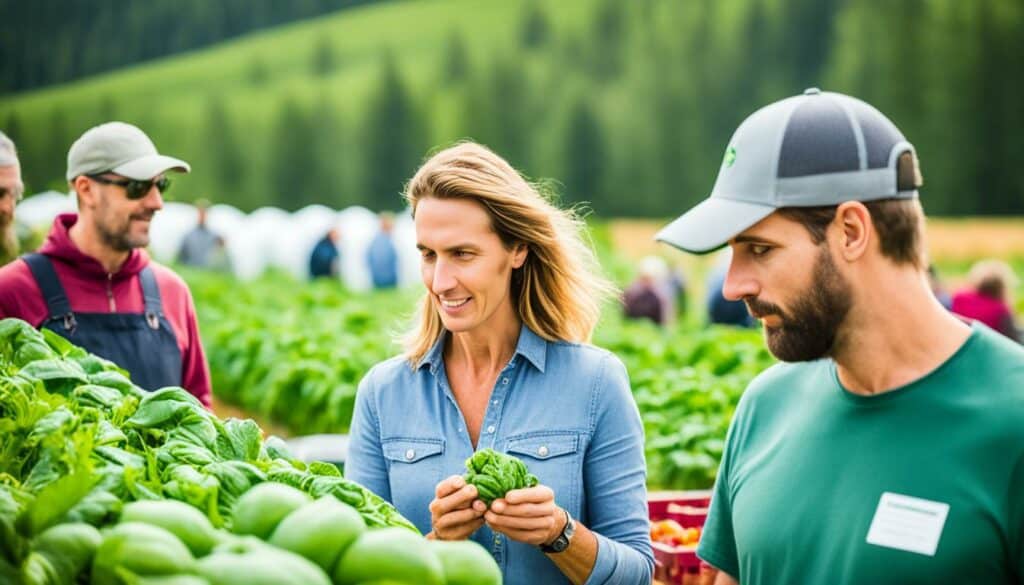
Studies at six farms in North Carolina in Fall 2018 and Spring 2019 showed key changes in consumer choices. Most people are ready to spend 5% more on local food. This signals a clear desire for food that is locally and sustainably produced.
Agritourism’s influence goes beyond immediate impacts, affecting long-term behaviour. Unlike regular shopping, agritourism supports farmers much better (around 7.8 cents more per dollar). These farm visits make people more likely to keep choosing local, sustainable food.
They also leave a lasting impression, promoting eco-friendly choices. Seeing the farms firsthand helps correct misunderstandings and boosts knowledge about farming. This leads to smarter, more responsible buying choices later on.
“Agritourism contributes to sustainability by helping family farms manage risks and preserve cultural heritage. By participating in these experiences, families develop a positive attitude towards supporting local food, influencing their long-term purchasing behaviours.” – National Research Agenda of the American Association for Agricultural Education
To sum up, agritourism is key in changing how we shop and think about food. Its impact on consumer choices and understanding of farming is significant. As people continue to change how they shop, agritourism will keep shaping our views on food and farming.
Since its start in 2018 at Ocean Isle Beach, the Vacationer Supported Agriculture (VSA) program has grown a lot. By 2021, it includes 11 North Carolina beach areas. It also covers two mountain spots. This shows how VSA really helps join tourists with local farms. And it boosts the use of fresh, local foods.
In Brunswick County, young people are getting a chance to work thanks to the VSA program. Since 2018, the Men & Women United group has been leading the “Vacation Vittles” VSA project.
Bear Ridge Farms has also seen a big change since they joined VSA in 2019. They’ve doubled how much they grow. This proves VSA is a good way to make more money from farm visits.
In 2021, VSA did really well in new places like Emerald Isle and Atlantic Beach. Ocracoke Island also did well. This success is thanks to the VSA team’s trainings. They taught people about safe food handling and how to take care of customers.
Right now in 2022, VSA is working to bring fresh food to more spots like the Northern Outer Banks. In 2021, it sold $91,397 worth of food in seven coastal counties. The plan is to work more than just the usual 12 weeks in summer.
Farmers from 11 counties get to sell their food straight to people on holiday. This gives them a good way to earn more money. The VSA project started well, selling more than $5,000 worth of food in Ocean Isle Beach.
Vacationer Supported Agriculture is not just about linking tourists to farms. It’s also about making sure farmers have a steady income. This keeps the bond between farming and tourism strong. With VSA, vacations can be full of tasty, local food. This helps both visitors and farmers.
The mix of agritourism and local food boosts leisure and learning alike. It blends tourism and farming, letting guests dive into the farm life. This way, visitors get closer to farming practices and see how local food is sustainably produced.
This combo of fun and education makes the trip more meaningful. Visitors learn and enjoy, developing a love for local food.
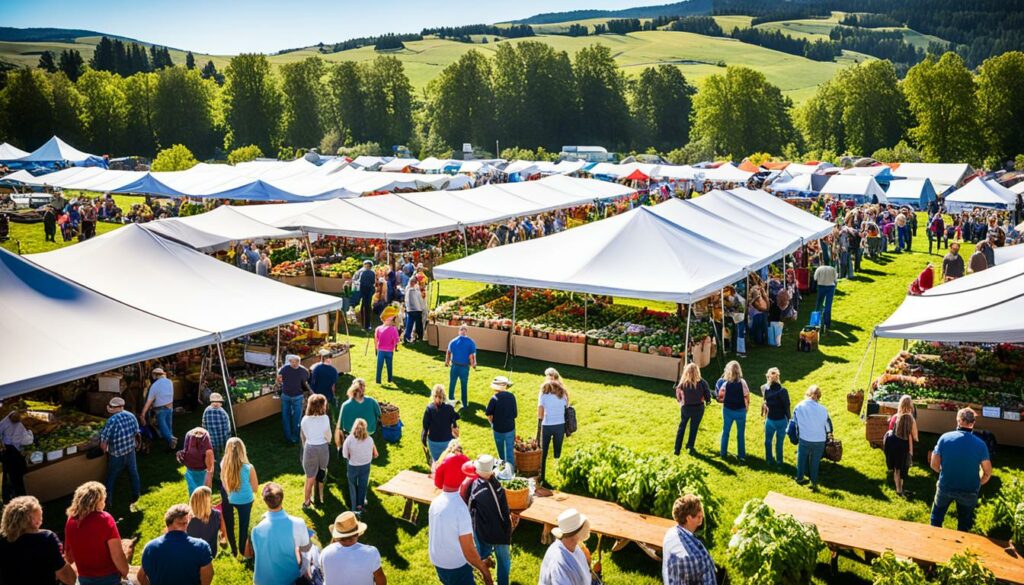
Agritourism covers a wide range, from picking your own berries to staying on a farm. It’s not just for fun; it’s a chance to learn about farming. For example, seeing a farm can show you how food goes from the farm to your table. It highlights the need for sustainability.
Mixing education with agritourism means visitors will appreciate farming more. They’ll understand the hard work that goes into producing the food they eat.
Agritourism boosts the area’s economy by joining tourism with farming. It creates a new income for farmers. It also draws in visitors who then spend money at local shops and restaurants.
By showcasing their culture, rural areas can stand out. Laws like Minnesota’s 604A.40 support this by helping local businesses grow. They provide guides and help with planning, making agritourism projects successful.
Exploring today’s agritourism and local food movements shows us ongoing challenges. These include the need to balance farming and tourism, along with issues in regulations. The field has expanded greatly, with many families joining in. Yet, making a living can still be hard.
In the US, rules for agritourism can change from one place to another. This makes things tough for farmers. They have to work hard to follow all the rules. An extra problem is making sure the local area can support these new businesses.
Farmers face the task of mixing tourist activities with their usual work. Agritourism can include selling direct, teaching, hosting, providing fun outside, and offering entertainment. Farmers must juggle all these to give visitors a great experience. It’s not just about the fun, though. Studies show these visits can change how people shop, encouraging them to buy more locally.
Local food movements have their own set of problems. Often, help is directed towards farmers, not buyers. This means it’s important to include more people in the local food story. To succeed in agritourism, farmers should consider joining groups like NAFDMA. Getting help from local government agricultural support is also smart.
There’s still a lot we need to learn about agritourism. Projects like the one at the University of Vermont are trying to find out what makes these ventures succeed. Working together, we can find ways to build a stronger, local-food-based future.
Agritourism is a key link between people and where their food comes from. It shows that mainly women, 77%, aged 30-49, are involved. They come from various backgrounds like White, Hispanic, Asian, and Black.
The scene is also marked by those with high incomes and education, aiming to increase their food expenses up to 20%. Their agricultural visits inspire them to back local food systems. This leads to a keenness in looking for local products.
Thanks to agritourism, visitors become more eco-conscious. They appreciate how buying local helps the environment. This appreciation leads to stronger support for local farming. Such actions are vital in influencing policies towards these sectors, creating a stronger and more united environment for everyone.
Agritourism is when visitors come to farms for fun and learning. This lets people see how food is grown. It connects them with farmers and the land. This matches the spirit of local food movements. They aim to get people excited about fresh, local foods and help the environment by supporting farms.
It started with farmers looking for new ways to earn money. They wanted to reach out to people living in cities. This approach benefits everyone. It keeps old farming methods alive. It also teaches people how important it is to eat food grown nearby.
For farmers, agritourism means more ways to make money. They can sell their products directly to visitors. This boosts their sales of fresh items. It also helps them farm in ways that protect the earth for the future.
People learn a lot about food and nature through agritourism. It makes them think about what they eat and where it comes from. They often start choosing foods that are good for the earth and support local farmers.
The farm-to-table movement is about using local food in restaurants. It helps local farms and gives customers fresh food. This way, people know the chefs are making meals with care and good ingredients. It makes everyone appreciate the hard work that goes from farm to table.
Rural tourism has many fun activities. There are tours where you can learn about farming. Visitors can stay on farms. They can also pick their own fruits and vegetables or buy them at farm shops. All of these let people have a great time while understanding and supporting local farming.
CSAs connect people directly with farmers. Consumers pay farmers in advance and get fresh food regularly. This supports farmers. It also helps the environment by encouraging farming that is good for the earth. This way, everyone can enjoy healthy, environmentally friendly meals.
Organic farming makes agritourism more interesting. It’s because many people want food that is good for them and doesn’t harm the earth. Showing people how organic farming works helps them appreciate the effort to grow food in a way that protects our planet.
Farm stays let visitors live on farms and join in daily routines. This is a great way to learn about farming and the importance of local foods. It changes how people think, making them more likely to support local farmers in the future.
North Carolina has done well in promoting agritourism, for example with the Fork to Farmer Initiative. These efforts have made people more aware of the value of local food. They keep traditional farming alive. Despite challenges, they found ways to help agritourism grow and succeed.
Culinary agritourism is about chefs and farmers working together. It introduces visitors to fresh, tasty local food. Projects like VSA let farmers sell their produce directly to visitors. This supports small farms and makes the local food economy stronger.
Visiting farms and seeing where food comes from leaves a lasting impact. It encourages people to choose food that is good for the earth. They learn to support local farmers by buying their produce. This changes the way they think about the food they eat.
VSA connects tourists with local farms. Visitors buy fresh, local food directly from the farmers. This helps small farms make more money. It also gives tourists the chance to enjoy delicious, fresh produce. It supports agritourism and the local food movement.
There are a few challenges like the size of farming areas, making good policies, and getting everyone involved. Solving these problems is key to making sure that agritourism and local food systems keep growing and stay good for the environment and communities.